Best Backpacking Stoves:
Where To Start?
By Diane Spicer
The best backpacking stoves are the ones that give you comfort food on the trail without creating hassle or drama.
- And put a fast hot meal into your hands when you really need one (see photo above).
But where to start in selecting the right stove for your backpacking style?
We'll cover your options in detail, and explain why slowing down to make a good choice will pay you back many times over on the trail.
If this sounds good, let's get started!
Best backpacking stoves:
start with fuel options
While you may be focused on the stove itself, a better place to start is with your backpacking cooking objectives.
The type of fuel your stove burns will determine whether you remain a water boiler, or can simmer or fry up some backpacking dinner goodness by regulating the flame.
The fuel source also determines the total weight and cost of your backpacking kitchen set, the types and sizes of cooking pot(s) to buy, and how big of a meal you can expect to serve up using the stove.
Options for backpacking stove fuel:
- Gas
- Wood
- Denatured alcohol
- Solid fuel tablets or pellets
Fuel choice may also restrict your travel backpacking destination choices if you don't plan ahead.
Whew, right?
Best advice
Here's the best advice if you feel overwhelmed:
- Go backpacking with someone who already has a stove, and watch carefully!
Or just keep reading about the best backpacking stoves...
Canister
backpacking stoves
These are the most popular type of stove for backpacking, and for good reasons.
They do have one important drawback to mention right away:
- Fuel canisters need to be recycled appropriately, not just tossed in the trash.
Okay, one more:
- You can't bring these canisters on airplanes, or order them on line (due to shipment restrictions).
- Plan ahead to include a physical trip to a gear store in your trip planning.
So finding fuel for a canister stove can be tricky on a backcountry trip that begins with a flight into a remote location.
And it's just one more wrinkle for international travelers to figure out.
An aside:
Please don't be the backpacker who "forgets to mention" your stove to the airline, it just creates hassles at the airport and makes the rest of us look bad ;)
Why are canister stoves
so popular
with backpackers?
Here's a list of reasons to explain why a compact, lightweight canister stove is a solid option for backpacking, especially for beginners:
- pre-pressurized fuel gets the stove going quickly
- no chance of a fuel leak or spill, due to canister design
- no learning curve for operation
- lightweight, durable metal design
- choice of burner sizes for different meal volumes
- simmer as well as boil, depending upon whether the canister can be integrated into the stove, or is separate from it (don't worry, each choice is easy peasy to use and is explained below)
A few recommendations will illustrate the pros and cons of a canister stove, and the photos give you a sense of its ease of operation.
You'll see two options: a direct attachment, and a remote canister style.
First, the most streamlined design.
A popular choice
(I use it myself)
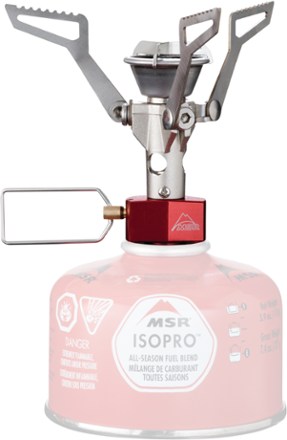 MSR PocketRocket 2 Stove | REI Co-op
MSR PocketRocket 2 Stove | REI Co-op
Notice how the red fuel canister attaches directly to the the stove?
- No hoses, no priming, no pumping, just a secure connection of fuel to burner.
The canister is greyed out in the photo to indicate that you buy it separately.
Recall the caveats:
- These fuel canisters are not sold on line, and as mentioned, that might be problematic at your backpacking destination if you're traveling by air and there is no gear store.
If you're at all hesitant about your ability to master a stove, a canister stove like this one makes a great choice for first time backpacking.
It's that easy to use, with little to no maintenance required.
Love my compact, lightweight PocketRocket stove!
However, it can be tippy, and is designed to accept small-ish cooking pots.
So this won't work for a crowd.
An integrated canister option
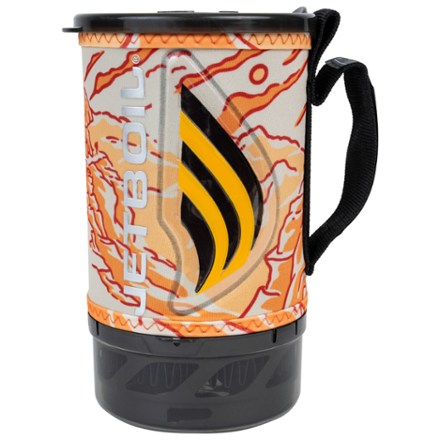 Jetboil Flash Cooking System | REI Co-op
Jetboil Flash Cooking System | REI Co-op
Another canister option with big benefits:
- stove + fuel canister + cook pot + windscreen, all in one unit
For a solo backpacker who just wants fast hot water, this stove eliminates dishes; just pack a mug and a long handled spork.
More to like about this backpacking stove:
- You can brew coffee in this one, if you spend a little extra.
- Packs up nice and small, including the canister nestled within.
- Super fast hot water, hence the name.
- Stands up fairly well to windy conditions.
Nice stove!
Tip:
This stove makes a nice option for snowshoers who want to melt snow into fast, easy hot water to mix up tasty beverages during a day hike, too.
But if you're looking for more control over the temperature, in order to simmer your meal, this stove isn't the best choice.
Here's a remote canister stove
that might be one of the
best backpacking stoves ever
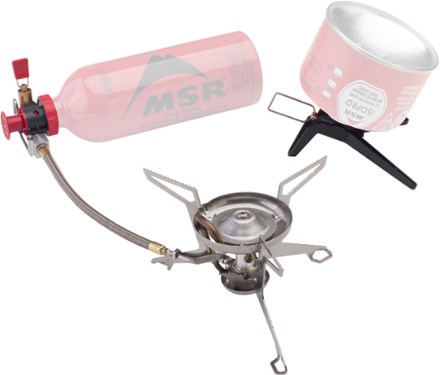 MSR WhisperLite Universal Backpacking Stove | REI Co-op
MSR WhisperLite Universal Backpacking Stove | REI Co-op
Why would you want this type of backpacking stove?
Note the wide arms for cooking pot stability regardless of pot size.
You can also use a windscreen with this canister stove (see safety note below), which is important for high altitude and cold weather cooking scenarios.
Also note the inverted canister on its stand in the photo: use this hack for cold temperatures to improve stove performance.
But did you catch the best part about this stove?
It burns a wide array of fuel!
- Universal, in other words.
And thus, you can choose whether to carry the fuel canister, or switch over to the bottle carrying liquid fuel (see tips below), depending upon your destination anywhere in the world.
Wow!
It's
easy to switch fuel sources, and this stove comes with all of the things you need to get things cooking and also keep the stove in top working order:
- fuel pump
- windscreen
- heat reflector
- small-parts kit
Handy pouch to keep it all together, too.
Note that the expected burn time using maximum flame will vary, dependent upon the type of fuel you're burning, and field conditions (temperature, wind, altitude).
Bottom line: if you're looking to invest in the best backpacking stove but don't yet know the full range of backpack trips you'd like to do, this is a good investment in gear, due to its versatility.
A few cautionary words
about fuel canisters
These small portable fuel cans self seal, meaning no worries about fuel leaks (which can be disastrous inside your backpack).
They are amazingly lightweight! But as mentioned, not re-usable - although you can recycle them in some locations.
If the stove performance is really important to you in less than ideal conditions, choose a stove that allows you the ability to regulate the pressure coming from the canister.
If you like the idea of blocking wind in order to speed up cook time and save fuel, think again about trapping heat with a close in screen.
- A canister explosion is nothing you want to deal with, ever.
- For that reason, read the manufacturer's specs to see if you should be using a windscreen or block.
What about the cost of canisters?
Not cheap, but then, having a hot meal is a good investment in a fun backpacking trip for many hikers.
A great question
So how do you know how much fuel is left at the end of the day?
You don't.
A big drawback!
But there's a way around it, and it involves lots of backpacking trips (that should make you smile).
- Keep track of your backpacking menus & volumes, trail conditions, and number of liters of water boiled along with stove run times each day in your trail journal.
- After several trips in varying weather and terrain, you will get a good feel for how much fuel you really need to be carrying.
- Meanwhile, carry a backup canister.
Not scientific enough for you?
- All fuel canisters float, but the water line will change as fuel is consumed.
- With a waterproof pen, mark the water line on a full canister floating in your kitchen sink before you leave for the trailhead.
- Bring the pen, and keep marking the water line as you consume fuel during your trip.
- Once you completely empty the canister, mark that line as well.
- Now you have a visual way to estimate the amount of remaining fuel - at least on that one particular type of canister.
Still not enough information for you to figure out how much fuel to carry on your backpacking trip?
MSR publishes a table of calculations to figure out the number of ounces of fuel required to boil 1 liter water on your particular stove.
- If you do more "simmer" type cooking, you might get more out of each ounce of fuel, or maybe not, depending upon temperature and altitude.
- Note that this is MSR data, so may not apply to other backpacking stove brands.
- Also note that these numbers are going to vary somewhat for your actual field conditions, but it gives you some guidelines on fuel consumption.
One more consideration
Also size up the size of the cooking pot (diameter) you'll be pairing with the stove (tips on backpacking kitchen essentials like pots here).
- Some of these little stoves won't handle a large diameter pot (short little arms, don'tcha know).
Had enough yada yada yada about canister backpacking stoves?
Let's move on to ...
Liquid fuel
best backpacking stoves:
pros and cons
I started out as a backpacker in the 1970s with a brass Svea small-ish liquid fuel pressurized burner stove.
That thing was kinda temperamental, and had a steep learning curve for how to prime it and regulate its flame without torching its surroundings.
I loved it!!
It's a vintage item these days, which technically makes me a fossil.
You, however, don't have to deal with a tempermental diva stove, because you have better options on the market, my friend!
Why choose a liquid fuel
backpacking stove?
If you've decided against a "universal" backpacking stove like the MSR Whisper Lite above, but like the idea of a refillable fuel bottle, you still have options.
Choose a liquid fuel stove when you:
- love the idea of using a refillable fuel bottle with the fuel of your choice (thus, can be used wherever liquid gas is available)
- hike in cold conditions and/or high altitudes, which can be challenging for other stove types
- go winter camping & will be heating lots of snow to the boiling point (other stove types aren't going to perform well for you)
- cook for a group of hikers i.e. larger cooking pots
- want full control over the temperature output
- don't mind learning how to use and maintain it correctly
Ultralight backpackers won't be carrying this type of stove, due to its weight and fuel requirements.
And a beginner backpacker might be challenged with the required fuel pumping and 2 control valves.
Consider this
liquid fuel stove if...
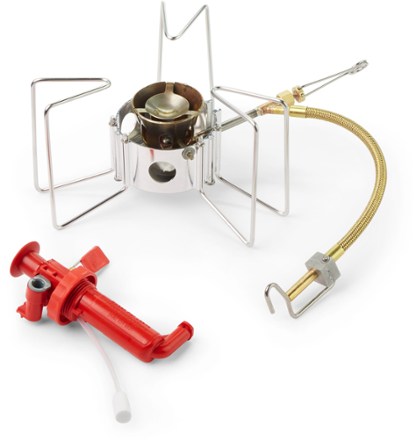 MSR DragonFly Backpacking Stove | REI Co-op
MSR DragonFly Backpacking Stove | REI Co-op
This stove is recommended for backpackers who are finicky about how to regulate the stove flame for dialed in temperature control while cooking a meal.
The magic happens via the control valves:
- You regulate gas flow from the fuel bottle with one valve.
- The other valve allows you to play with the flame so you can boil, simmer and anything in between.
This stove has you covered anywhere in the world, because it burns white gas, kerosene, diesel, auto fuel (not the best choice as it can clog up the stove), aviation gas, stoddard solvent and naphtha.
- But not alcohol
Cooking for a group, using a 10 inch diameter pot?
- This stove won't tip over and spill the beans.
Conversely, it doesn't handle smaller pots well.
Like car camping as well as backpacking?
- This is the flame delivery system for your versatile needs! And it stands up to getting knocked around some, as will happen with heavy usage.
Having been in the presence of a Dragonfly stove, I have to tell you that it's pretty loud.
Not ear plug loud, but you'll definitely know it's running.
- But to me, the roaring sound is a good sign that dinner is on the way!
- And if you have extra money lying around, you can hack this stove with an afterburner to quiet it down.
Also note that with valves and pump, comes a commitment to maintenance and parts replacement.
All in all, this stove can go from group backpacking to car camping to tail gating, and provide good service for those of us who enjoy spending time crafting a backpacking meal.
But hey! we're not done yet in our quest for the best backpacking stoves.
You have options for fuel that might not have occurred to you in the outdoor stove realm.
Wood burners:
best backpacking stoves?
Say what?
Yes, really! A little wood burner all your own.
Here's all you need to know about backpacking wood stoves.
They appeal to ultralighters with a steady woody twig supply, AND they boil water.
If that's you, take a look at this beauty:
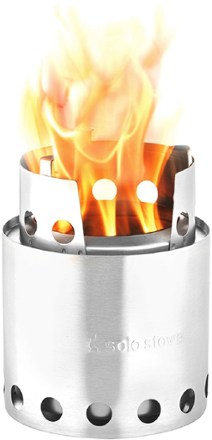 Solo Stove Lite Stove | REI Co-op
Solo Stove Lite Stove | REI Co-op
Kinda like having your campfire and your boiling water, too!
It's perfect for rehydrating your freeze dried meals and instant breakfasts with boiling water.
Attempting to simmer with this stove?
- Not gonna happen.
The technical jargon for the stove design: a natural convection, inverted downgas gasifer stove.
What's really happening is getting combustion to occur quickly, and to keep it going in the presence of wood fuel, creating heat but not a lot of smoke.
Keep this in mind if you're
considering this type of stove
Let's mention a few issues you need to consider if you're thinking these are the best backpacking stoves.
Your hiking destination may not have an ample supply, or any, hardwood as forest litter, which is the recommended fuel type.
Dry, downed twigs and small branches is what you'll need.
- Be sure to Leave No Trace if you're hunting for biofuel to cook your breakfast.
- And that includes dealing with the wood ashes.
Come up with a method to deal with soot buildup,and be prepared to store a used stove without a huge mess in your backpack.
These stoves gobble up twigs quickly.
- Be sure you've gathered an ample supply before you begin cooking, without denuding your surroundings.
- Realize that your cook time will be impacted if your fuel supply runs out.
Do you really want to be using this one in windy terrain, especially during a burn ban? Please say no!
Tip:
If
you carry an emergency fire starter like dryer lint rolled in petroleum
jelly (my fave), it might get pressed into service with a wood stove
like this one, so bring lots of it to enhance ignition in less than ideal conditions.
Another solidly built option with a different design to consider:
- folds flat for a smaller footprint inside your backpack
- titanium stands up to a lot of use
- access door is hinged to help you with fuel placement
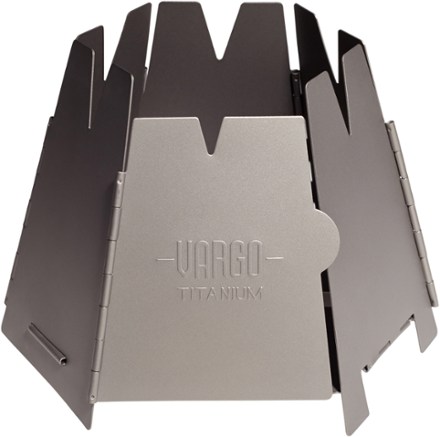 Vargo Titanium Hexagon Backpacking Wood Stove | REI Co-op
Vargo Titanium Hexagon Backpacking Wood Stove | REI Co-op
Trendy, or alternative?
Because I grew up in a house heated with wood, a backpacking stove that burns wood does not sound all that alternative, although that's how trendy gear stores will advertise them.
But solid fuel burning stoves?
Now we're talkin' alternative backpacking stoves.
Solid fuel
best backpacking stoves
Going to a place without wood or other biofuel resources?
Don't like the idea of metal fuel canisters or bottles of liquid fuel?
Want to go lightweight (7 ounces!!) at extremely low cost ($30 US)?
Only need boiling water to reconstitute your dehydrated backpacking meals and brew some tea?
If you answered YES! then take a look at this stove with an integrated cooking pot and built in wind screen.
- SEVEN ounces, people!
- The pot holds 20 fluid ounces of water, enough to make breakfast for one: a bowl of instant oatmeal and a mug of tea.
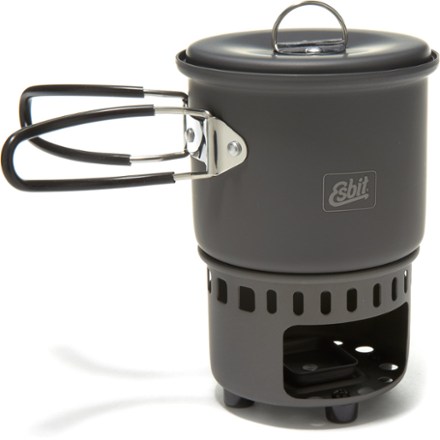 Esbit Solid Fuel Stove and Cookset | REI Co-op
Esbit Solid Fuel Stove and Cookset | REI Co-op
Fuel efficiency is not a strong point with this stove, so bring lots of tablets for a long trip.
And be forewarned: Double bag them, along with the stove,or risk an offensive odor seeping through your backpack.
There will also be a black gooey buildup to contend with, which double bagging will handle.
This company also makes a pocket version if one cup of hot water at a time floats your boat.
- Insanely small!
Tip:
Fuel tablets may or may not (probably may not) be available where you're going, so plan ahead.
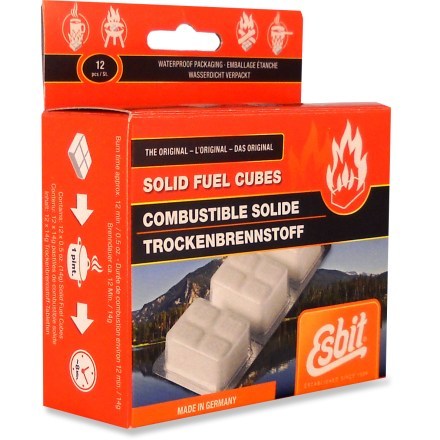 Esbit Solid Fuel Tablets | REI Co-op
Esbit Solid Fuel Tablets | REI Co-op
Alcohol burning stoves
are also on the list of
best backpacking stoves
Yet another trip down memory lane!
A home made alcohol burner can be fueled with Heet, the stuff in bright yellow bottles that I used to put into my gas tank in frigid upper Michigan winters.
- Anti-freeze, or stove fuel - you decide.
- Either way, it's cheap and convenient to carry.
However, this type of fuel has some safety issues.
The flame is hard to see and quiet, so it's possible to knock over the stove while it's operating and ignite whatever is around it, including you.
- It's a no-no during a burn ban, just as a wood stove would be.
You can't regulate the flame, and will have to budget a fair amount of time to get your water boiling.
For these reasons, Hiking For Her is not a fan of these types of backpacking stoves.
If you're intrigued, a quick internet search will yield instructions on how to turn a beverage can into a serviceable stove, something any budget conscious, weight vigilant backpacker can appreciate.
Just be careful with it, please!
Additional backpacking
stove notes for you
If you've never backpacked before, you might not realize what it's like to set up and use a stove in field conditions.
So I'll share a few gear hacks and suggestions with you.
Wet conditions
If you're headed into wet conditions, or even think you might be, think about how you can shield your stove and fuel source as much as possible from direct rain.
Let's be realistic, it's gonna rain on most of us!
So bring a waterproof stuff sack to stow your cooking kit inside your backpack.
Consider rigging a tarp to keep the rain off the stove, as in the photo at the top of the page.
- Makes a nice wind break if you situate it properly, too.
Create a solid flame proof foundation for the stove with whatever is available, rather than plopping it into the mud.
Tip:
- Consider eating a cold meal until the blustery wet weather passes, rather than fight with the stove or its fuel (wet wood).
Windy, breezy, gusty
conditions
Backpacking stoves are notorious for poor performance in windy areas.
But there are other things to note in these conditions.
A wind screen will help keep the flame directed toward the cooking pot, but won't trap all of the heat.
Some of the stoves mentioned have integrated wind screens.
Others will need a hack from you.
- Folded up aluminum foil strips
- Thin metal shield of appropriate height and width
And remember, some canister stoves are incompatible with close fitting wind screens, due to excessive heat build up.
Know your stove!
Winter camping
If the idea of sleeping in a snow igloo you built that afternoon sounds like heaven, you're a winter backpacker.
Your stove becomes even more vital to survival in winter conditions, so take the time to make sure it operates at peak capacity.
Start with a thorough inspection of your stove and its components.
Anything look a little iffy?
- Replace it, or bring a spare.
This is important with liquid fuel stoves, which are the best kind if you plan to melt snow for water or do a lot of cooking in cold temperatures.
Never used this stove before?
While I'd recommend that you not try out a stove for the first time in extreme winter conditions, if you must, then promise that you'll read the instruction manual.
All of it.
Twice.
Once you get to your campsite, dig out a base for the stove, or maybe even bring along a homemade wooden or metal block designed to hold it securely on top of the snow.
Let's sum it up
Ready for a recap?
No offense, but your backpacking style puts you into a gear category, including stoves.
Figure out where you belong in the scheme of things, then buy a backpacking stove to suit your needs:
Find your style, then your stove
|
Your style & cooking preferences |
Stove types for you to take a hard look at |
|
Weight is important, so is cost; solo hiker + boiling water |
Wood burning stove Solid fuel stove + tablets Homemade alcohol stove |
|
Boiling water is all it takes to get you fueled up & happy, but you don't want to wait around for it Control freak that you are, simmering makes you happy - frying and baking, too You plan to backpack in multiple countries, so a versatile stove is essential You never backpack alone, so a large capacity stove is important You're a beginner backpacker, so make it easy! |
Only a remote canister stove could let you down, and only in cold conditions A remote canister, or a liquid fuel stove, with valves for control of fuel and flame MSR Dragonfly multiple fuel burner or similar Some types of canister and liquid fuel stoves; check the specs for burner dimensions and output Canister stoves have no learning curve and little maintenance worries |
Fair warning,
stove buyers!
You know how you have different backpacks for different types of hiking?
Look out!
You're going to want to add to your backpacking stove collection when you start experimenting with winter camping, or want to take a group of your friends on a backpacking trip.
And when your stove decides that wind isn't very conducive to heating up, you'll want to try some different options.
- Note: wind and backpacking stoves never get along very well, don't take it personally
Yes, stove envy is real, and don't say I didn't warn you.
You might have noticed that you fit into more than one category of best backpacking stoves, right?
Don't fight it!
As you grow and learn as a backpacker, your gear list must expand.
Examples:
One last little
but important
backpacking stove tip
Bring a source of ignition with you.
If you forget to add this item to your gear list, or forget to toss it into your cook pot, you'll be a hangry and unpopular hiking companion.
Choose a method of getting that stove fired up, or bring both for redundancy:
- old school waterproof backpacking matches
- bombproof lighter
Because no hot coffee in the morning?
Stone cold oatmeal?
That's just sad!
Now what are you going to cook with your stove?
- Best backpacking meal ideas for beginners here
- Backpacking food ideas
- Jazz up your backpacking meals
Home page > Best Backpacking Tips >
Best Backpacking Stoves For Your Hiking Style
Hiking For Her is an REI affiliate and has five decades of REI gear field usage (that's alotta backpacking meals), so when you purchase through the HFH website, you're getting the best of the best and also helping to keep the hiking tips freely flowing.
Much appreciated!
|
I get emails all the time about what I wear, eat, carry and love to use on the trail. That's
why I provide affiliate links to you: the best gear that I use myself and have seen used by other hikers is instantly
available for your consideration, and the gear company sends a few
pennies per dollar to this reader-supported hiking website. There is no added cost to you! Everyone ends up a winner: Great gear for you, strong gear companies, and more free hiking tips for everyone. Thanks very much for your support. It's warmly and sincerely appreciated. It also helps send these hiking tips to all your virtual trail buddies around the globe. |
 |



